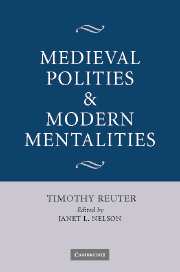Book contents
- Frontmatter
- Contents
- Editor's note
- Acknowledgements
- List of abbreviations
- Editor's introduction
- PART I MODERN MENTALITIES: HISTORIOGRAPHIES, METHODOLOGIES, PRECONCEPTIONS
- PART II THE SYMBOLIC LANGUAGE OF MEDIEVAL POLITICAL ACTION
- 7 Nobles and others: the social and cultural expression of power relations in the Middle Ages
- 8 Regemque, quem in Francia pene perdidit, in patria magnifice recepit: Ottonian ruler representation in synchronic and diachronic comparison
- 9 Contextualising Canossa: excommunication, penance, surrender, reconciliation
- 10 Velle sibi fieri in forma hac: symbolic acts in the Becket dispute
- PART III POLITICAL STRUCTURES AND INTENTIONS
- Index
9 - Contextualising Canossa: excommunication, penance, surrender, reconciliation
Published online by Cambridge University Press: 12 August 2009
- Frontmatter
- Contents
- Editor's note
- Acknowledgements
- List of abbreviations
- Editor's introduction
- PART I MODERN MENTALITIES: HISTORIOGRAPHIES, METHODOLOGIES, PRECONCEPTIONS
- PART II THE SYMBOLIC LANGUAGE OF MEDIEVAL POLITICAL ACTION
- 7 Nobles and others: the social and cultural expression of power relations in the Middle Ages
- 8 Regemque, quem in Francia pene perdidit, in patria magnifice recepit: Ottonian ruler representation in synchronic and diachronic comparison
- 9 Contextualising Canossa: excommunication, penance, surrender, reconciliation
- 10 Velle sibi fieri in forma hac: symbolic acts in the Becket dispute
- PART III POLITICAL STRUCTURES AND INTENTIONS
- Index
Summary
On 27 or 28 January 1077 the excommunicated German king Henry IV, after standing in sackcloth and barefoot in the snow on three successive days in the courtyard of the Tuscan margraves' castle at Canossa, was allowed into the presence of Pope Gregory VII, who lifted the sentence of excommunication which had been laid on him the previous year, on certain conditions. The immediate resonance of the act was perhaps less than we might have expected, certainly less than the immediate resonance of Henry IV's excommunication nearly a year beforehand. But awareness of its importance and its symbolic significance gradually grew, then and since. Many reformers of the sixteenth century saw Gregory VII's pontificate as a turning-point, the moment at which the medieval church took the crucial step down the road to popery. With the revived nineteenth-century interest in the Kaiserzeit, Canossa took on a new, nationalistically interpreted meaning. Plans to include the scene in the historic wall-paintings in the restored Salian palace at Goslar – a crystallisation of the link between the new Reich and the old one – were modified to the extent that the scene as depicted lost most of its meaning, as a result of a public outcry and official intervention. When in 1872 Bismarck said, ‘We shall not go to Canossa, neither in body nor in spirit’, he did not have to spell out the allusion.
- Type
- Chapter
- Information
- Medieval Polities and Modern Mentalities , pp. 147 - 166Publisher: Cambridge University PressPrint publication year: 2006
- 3
- Cited by



